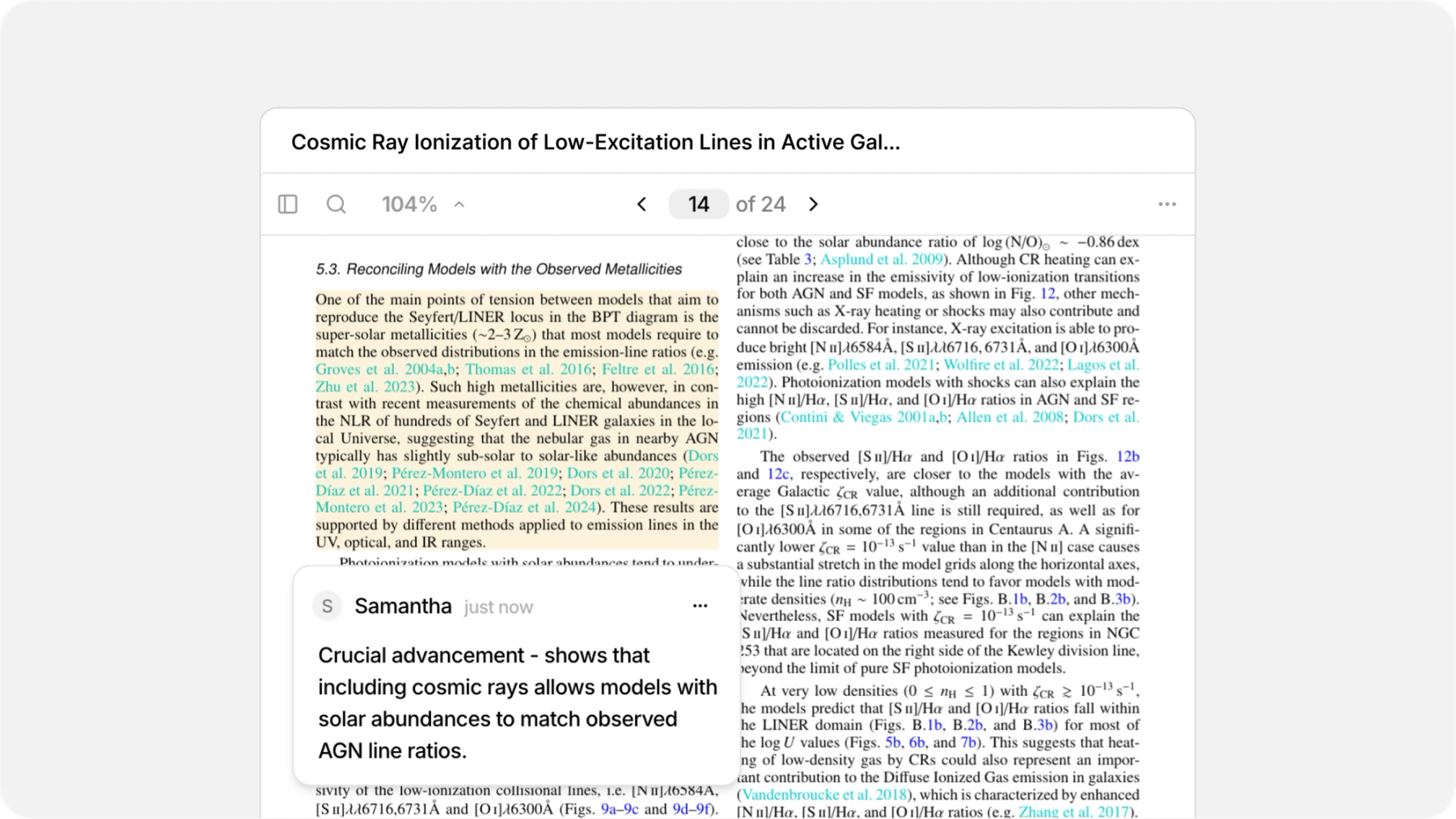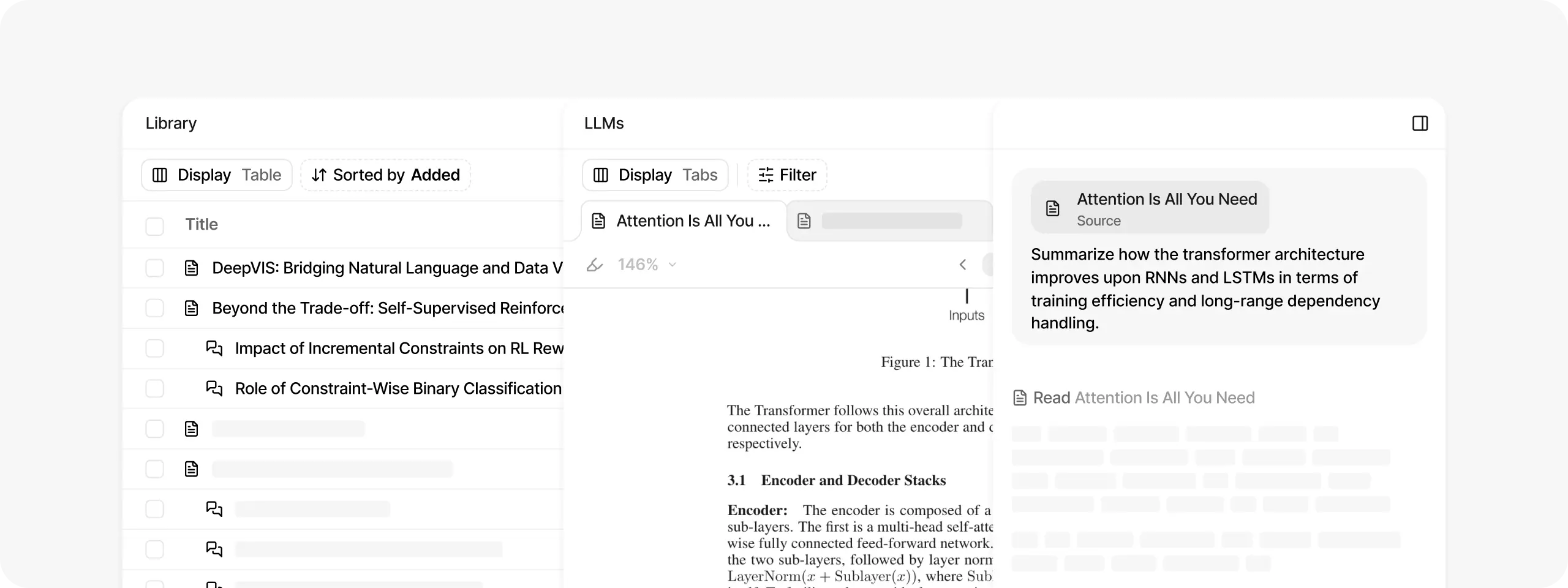8 trusted AI tools that provide sources correctly
With over 3 million new papers published each year, manually scanning literature is no longer viable. AI tools have emerged to help researchers discover, analyze, and cite sources more efficiently—but they take different approaches.
Some tools enable searching academic databases, while others help you reference sources you've collected in your own personal library. Here's your complete guide to AI solutions providing sources organized by what they do best.
1. Anara: AI that references your sources
Anara is an AI tool that provides sources from your own research collection with verifiable citations.
Unlike tools that search external databases, Anara works with sources you've already gathered—PDFs, videos, audio recordings, web articles, and images. Every AI response includes "source highlighting" that shows exactly where insights come from in your documents.

How is Anara’s approach to citing sources different from other tools?
- Your sources, your control: Research rarely fits neatly into academic databases. You collect papers from multiple sources, conference proceedings, preprints, lecture videos, interview recordings, and web articles. Anara works with your complete research ecosystem.
- Verifiable AI responses: "Source highlighting" eliminates AI hallucinations by linking every insight back to specific passages in your sources. You can instantly verify where AI generated information comes from.
- Multimedia research capabilities: Analyze videos, audio recordings, and images alongside traditional papers. Perfect for interdisciplinary research that goes beyond text documents.
- Collaborative research workflows: Real-time shared workspaces where research teams can upload sources, ask questions, and write together in one integrated platform.
- Integrated writing environment: Citation management and AI-assisted writing built into the same platform where you analyze sources. No switching between tools.
Anara's source highlighting shows me the precise section where data comes from, so I can understand the context and share accurate information with my team.
A chemistry PhD turned clean tech CTO
Example workflow with Anara
- Upload your research collection (PDFs, videos, lecture recordings, web articles)
- Ask questions like "What are the main methodological approaches across these studies?"
- Get AI responses with referenced sources showing exactly where information comes from
- Use the integrated editor to write with automatic AI citation generation
- Collaborate with team members in shared research workspaces
When to use Anara?
When you need AI that provides verifiable sources in your research collection, supports multimedia content, or requires team collaboration.
Let’s look at how other AI tools cite sources from large academic databases using AI-powered search and analysis.
Your research assistant that links every answer to your sources
Get Anara free2. Elicit
Elicit searches through papers from Semantic Scholar and extracts specific data points (methods, outcomes, participants) for systematic reviews. This AI provides sources by linking AI-generated insights directly to the research papers analyzed, with a transparent and editable table that keeps citations visible throughout the workflow.
Strengths in this approach
- Accurate data extraction for empirical studies
- Natural language queries that go beyond keyword matching
- Purpose-built for systematic review workflows
Limitations in this approach
- Limited to open-access full texts (falls back to abstracts otherwise)
- Confined to Semantic Scholar's database coverage
- Primarily individual-focused with minimal research collaboration tools
3. Scite
Scite is an AI that provides sources by referencing real scientific papers with DOIs and highlighting the exact sentences used from the full text. It processes full-text articles to build a database of Smart Citations, showing not only which papers cite each other but also the context and location of each citation within the citing paper. Users can also customize reference settings and view citation statements and metrics.
Strengths in this approach
- Unique citation context analysis (supporting vs. contradicting)
- Massive citation database for credibility assessment
- Excellent for AI-assisted literature reviews requiring citation validation
- Strong institutional adoption
Limitations in this approach
- Doesn't summarize paper content—only shows citation relationships
- Coverage depends on publisher partnerships, meaning some papers or fields may have less coverage
- Not designed for content synthesis or writing workflows (e.g., drafting literature reviews)
4. SciSpace (formerly Typeset)
SciSpace uses AI to provide sources for answers extracted directly from specific papers or PDFs, which users can filter by publication type or year. Its Copilot tool explains concepts and answers questions from within the paper itself, making it easy to trace insights back to the original text. Referenced papers are summarized in structured tables, offering a clear, source-backed mini-literature review.
Strengths in this approach
- AI explanations for complex research concepts
- Good academic paper coverage
- Helpful for interdisciplinary research
- Built-in citation formatting
Limitations in this approach
- Surface-level summarization for complex topics
- Limited collaboration features
- Focuses on discovery rather than comprehensive research workflows
In the section below, we’ll cover AI tools that help researchers understand how papers relate to each other through citations, rather than analyzing paper content directly.
Related: Try some of the best AI tools for reading research papers.
5. Semantic Scholar
Developed by the Allen Institute for AI, Semantic Scholar uses AI to extract and analyze citations from millions of papers to build citation graphs that show how research is interconnected. Its algorithms understand the context of each paper, e.g. research questions and methods, to recommend relevant sources beyond keyword matching. It can also provide AI-generated summaries, formatted citations, and tools to streamline reference management.
Strengths in this approach
- Clean, intuitive interface
- Citation influence metrics
- Email alerts for new relevant papers
- Strong paper recommendation engine
Limitations in this approach
- Limited synthesis capabilities (it won’t generate comprehensive literature reviews or integrate findings across multiple papers automatically)
- Requires manual organization of findings
6. Connected Papers
Connected Papers maps research papers based on conceptual similarity. It uses co-citation and bibliographic coupling to surface papers with overlapping references, then organizes them in a visual graph where each node represents a real, traceable source. Users can interactively explore the network and view full details of each connected paper, making the source discovery process both structured and transparent.
Strengths in this approach
- Intuitive visual representation of citation networks
- Great for identifying key papers in a field
- Helps understand research evolution over time
Limitations in this approach
- Visualization-focused rather than content analysis
- No AI-powered insights about paper content
- Limited writing or collaboration support
7. Consensus
Consensus uses AI to cite sources by combining advanced natural language processing, deep learning, and custom language models to extract, summarize, and reference scientific research directly in response to user queries.
Strengths in this approach
- Synthesizes findings across multiple studies
- Quality scoring for research evidence
- Good for evidence-based decision making
Limitations in this approach
- Primarily medical/health focus
- Limited to specific research domains
- No comprehensive research workflow support
8. Sourcely
Sourcely is an AI tool that provides sources by finding relevant academic papers and citations from input text, essay, or paper. Users can paste their text and receive targeted citations, summaries, and free PDF downloads for many sources. Sourcely also exports references in various citation formats and allows their organization in a personal library.
Strengths in this approach
- Access to over 200 million papers
- Advanced filters for publication year, authorship, and relevance
- Instant citation export
Limitations in this approach
- Database may lack breadth in some niche areas
- Source relevance may differ for some domains
What matters when choosing an AI that references sources?
The core problem with most AI tools is you can't trust what they tell you. Here's what separates reliable source-referencing AI from sophisticated hallucination machines:
1. Source traceability (non-negotiable)
Source highlighting is the gold standard. Tools like Anara link every AI response directly to specific sections in your documents. Click on any claim and it shows you exactly where that information came from. This isn't convenience, it's source verification.
Citation context matters differently. Tools like Scite show you how papers cite each other (supporting, contradicting, mentioning) but don't analyze content. It’s useful for understanding citation relationships, less helpful for content analysis.
Avoid ChatGPT for academic writing: AI based on general knowledge models give you answers without showing exactly where they came from. "Based on your documents" isn't good enough. You need paragraph-level precision.
Upload your research collection and see source highlighting in action
Get Anara free2. Working with your sources vs. generic databases
Personal library approach (Anara): The AI only works with documents you upload. Pro: Complete control over source quality, zero hallucination from random internet content. Con: You have to curate everything yourself.
Database-driven approach (Scite or Elicit): AI pulls from massive academic databases or the web. It’s helpful for broader discovery of sources you might have missed. However, the results are dependent on the corpus quality and coverage and may be expensive if you london’t have access to institutional subscription.
The trade-off: Personal libraries give you bulletproof verification but require more work sourcing research materials. Database tools offer discovery but less control over source reliability.
3. Source verification
Direct document linking beats everything else. When the AI makes a claim, you should be able to click and see the exact text it's referencing. This works whether you're fact-checking or building on the AI's analysis.
Source quality indicators help with database-driven tools. Look for impact factor ratings, peer-review status, or publication credibility scores.
Transparent methodology matters for systematic work. Elicit publishes their extraction accuracy rates (94-99% for systematic reviews). Most AI research tools don't validate their performance at all.
4. Content type coverage
Text-only limitation kills most tools for modern research. If your sources include videos, audio recordings, presentations, or images, you need tools like Anara that can process multimedia and still provide source traceability.
OCR capabilities matter for scanned documents. Useless to have source referencing if the tool can't read your historical papers or handwritten notes.
5. Real-time source management
Live document updates are crucial if you're building research over time. When you add new sources, the AI should incorporate them immediately, not require rebuilding your knowledge base.
Source organization affects reliability. Tools that let you organize sources into collections or projects (like Anara's Collections feature) make it easier to maintain source quality and context.
What doesn't matter much
Number of sources in the database sounds impressive but misses the point. A million low-quality sources are worse than a hundred high-quality ones you've vetted.
Citation format export is table stakes. Every decent tool handles BibTeX, APA, MLA. Don't choose based on citation styles.
AI model sophistication gets overhyped. GPT-4 vs Claude vs other models matters less than whether the tool can trace its outputs to your sources.
Red flags
"Trust me" responses without source links. If the AI can't show its work, it's not suitable for research.
Mixing sourced and unsourced content in the same response. Some AI tools blend information from your documents with general knowledge, making verification impossible.
Vague source attribution like "according to your research" or "based on the literature" without specific document references.
Key takeaway
Many ChatGPT alternatives for research give you confident-sounding answers with no way to verify accuracy. For research work, this is worse than useless, it can be career damaging.
Choose tools where:
- Every AI claim links to specific source sections
- You control what sources the AI accesses
- Verification takes one click, not detective work
- The tool works with your actual research materials (not just what's in their database)
Skip tools that:
- Can't show exactly where information came from
- Mix sourced and general knowledge without distinction
- Pull quotes or references based on metadata (title, abstract)
- Can't handle the content types you actually work with
The goal is to get AI providing verifiable sources and insights that you can build on with confidence. If you can't verify sources, you can't use them for serious research.
